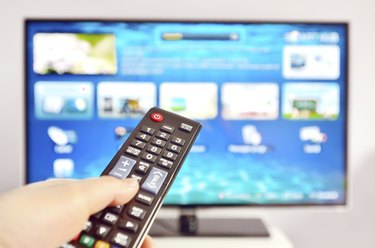
If you're shopping for a new TV and find yourself bewildered by the difference between a smart set and one that's Internet-ready, you're not alone. As the technology continues to develop, so do its marketing labels and descriptions. An Internet-ready TV uses your home network to connect directly to the Internet, either through Wi-Fi or with an Ethernet cable. A smart TV can connect to the Internet directly or through an Internet-enabled appliance such as a set-top box.
Change in Marketing
Video of the Day
Most articles that discuss Internet-ready TVs date back to before 2012. Even as late as 2011, most uses of the term "smart TV" referred only to a TV or TV set-top box that allowed you to surf the Internet much like a computer, usually with a keyboard. If it couldn't browse freely through any website, it wasn't a smart TV. An Internet-ready or Internet-connectable TV described any set that used apps to stream video, play games or access specific websites, but did not allow you to browse websites outside of those apps. By 2012, however, you would have had a difficult time finding any TV described as "Internet-ready." Nearly every TV manufactured since 2012 that can connect to your home network without an intermediary set-top box qualifies as a smart TV.
Video of the Day
Choosing a Smart TV
Prices fluctuate all the time, but screen size, resolution, and whether the TV uses an LED, LCD or plasma screen determine the price of any HDTV. Expect to pay a several hundred dollars more for a smart TV than for an HD set without built-in Internet connectivity. Most smart TVs include basic services such as YouTube, Hulu and Netflix. If you plan to make video calls from your TV, verify that the set can access a service such as Skype or Google TV. A smart TV's basic services don't carry a cost, but you'll pay separately for individual subscriptions, including Hulu Plus and Netflix. Whether you rent or purchase movies through iTunes or Google TV, or use a proprietary package such as Sony models offer, you'll pay for each rental or purchase individually. If you're looking for a particular game or video service, verify its availability on a TV before you buy the set. You may be able to upgrade your service in the future, but you can't guarantee that you'll have access to specific applications.
Smart TV Set-Top Boxes
The prices for smart TV set-top boxes can range between $50 and $500, depending on features and capabilities. At the low end, basic boxes like the NetGear NeoTV Wireless Media Player connect to CinemaNow, Netflix, Pandora, Facebook and YouTube. At the higher end, the TiVo Premiere Elite High-Definition Digital Video Recorder accesses Netflix, YouTube and Pandora, and records up to 300 hours of high-definition videos, TV shows and movies. Between these extremes, you'll find set-top boxes made by D-Link, Western Digital, Roku, Sony, Apple, Logitech and D-Link. Apple TV connects your Apple computer, iPhone or iPad, and other services to the TV. The Logitech Revue uses the Android operating system for use with Google TV, Android-based apps and the Logitech media player for accessing your own music, videos and photos. It includes a keyboard and touchpad, and ties in to your home network through either Wi-Fi or Ethernet. It requires an HDMI port on the TV and another on your cable, satellite or telco digital receiver.
Other Devices
Besides set-top boxes, other devices can smarten up your regular HD TV to some extent. Game consoles like the Wii, Playstation 3 and XBox 360 give you access to Internet-based services such as HuluPlus or Netflix. Many Blu-ray players and home theater systems also access Internet-based services. Sony and Toshiba models, for example, connect to CinemaNow, Netflix, Pandora and YouTube. Toshiba also offers Picasa connectivity. Other Blu-ray player Internet services vary depending on the manufacturer. Read the fine print to see which services you can use with each brand and model. For example, to use your paid Netflix account with an Xbox, you also pay for a subscription to Xbox Live.